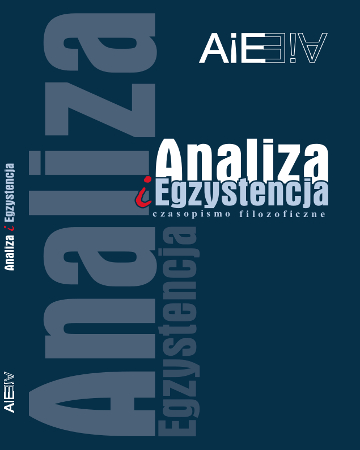
ISSN: 1734-9923
eISSN: 2300-7621
OAI
DOI: 10.18276/aie.2021.56-03





Issue archive /
56 (2021)
Conspiratio maligna w naczyniu, czyli globalne teorie spiskowe a sceptycyzm
(Conspiratio maligna in a vat, i.e. global conspiracy theories and skepticism)
| Authors: |
Szymon
Makuła

Uniwersytet Śląski |
| Keywords: | conspiracy theories skepticism brain in a vat Hillary Putnam |
| Data publikacji całości: | 2021 |
| Page range: | 21 (53-73) |
Abstract
The paper presents a comparison of a particular type of conspiracy theory, the so-called global malevolent conspiracy theory, with Hilary Putnam’s famous thought experiment concerning brains in a vat. Holding the belief that there is such a thing as a malevolent conspiracy places one in a position similar to the aforementioned brain in a vat situation. This is a result of conspiratio maligna’s unrestricted ability to influence, control, or even to create every aspect of our social, political and economic life. The unlimited power of such a mysterious organization is the reason why its victims cannot trust anyone, including their government, scientists, or even other conspiracy theorists. Literally every man, woman and institution are suspected of being bribed, controlled or intimidated by conspiracy. There is only one possible solution to this situation, and it is to remain skeptical about everything.
Download file
Article file
Bibliography
| 1. | Aaronovitch D. (2009), Voodoo Histories: The Role of The Conspiracy Theory in Shaping Modern History, Riverhead Books, New York. |
| 2. | Abalakina-Paap M., Stephan W.G., Craig T., Gregory W.L. (1999), Beliefs in Conspiracies, „Political Psychology” 20 (3): 637–647. |
| 3. | Basham L. (2003), Malevolent Global Conspiracy, „Journal of Social Philosophy” 34 (1): 91–103. |
| 4. | Basham L. (2006), Living with the Conspiracy, [w:] Conspiracy Theories: The Philosophical Debate, D. Coady (red.), Ashgate, Hampshire: 61–77. |
| 5. | Brotherton R. (2013), Towards a definition of conspiracy theory, „PsyPAG Quarterly: Special Issue: The Psychology of Conspiracy Theories”: 9–14. |
| 6. | Byford J. (2011), Conspiracy Theories. A Critical introduction, Palgrave MacMillan UK. |
| 7. | Coady D. (red.) (2006), Conspiracy Theories: The Philosophical Debate, Routledge London. |
| 8. | Clarke S. (2007), Conspiracy Theories and the Internet – Controlled Demolition and Arrested Development, „Episteme” 4 (2): 167–180. |
| 9. | Dentith M.R.X. (2014), The Philosophy of Conspiracy Theories, Palgrave MacMillan UK. |
| 10. | Dentith M.R.X. (2016), When Inferring to a Conspiracy might be the Best Explanation, „Social Epistemology” 30 (5-6): 572-591. |
| 11. | Dwight C.S. (1976), Mafia: The Prototypical Alien Conspiracy, „The Annals of the American Academy of Political and Social Science” 423 (1): 75–88. |
| 12. | Furnham A. (2013), Commercial conspiracy theories: a pilot study, „Frontiers in Psychology” 4 (379). |
| 13. | Grzesiak-Feldman M. (2010), O związkach lęku z myśleniem spiskowym, „Studia Psychologiczne” 48: 45–58. |
| 14. | Grzesiak-Feldman M. (2016), Psychologia myślenia spiskowego, Wydawnictwo Uniwersytetu Warszawskiego. |
| 15. | Goertzel T. (1994), Belief in conspiracy theories, „Political Psychology” 15 (4): 733–744. |
| 16. | Goertzel T. (2010), Conspiracy theories in science, „EMBO Reports” 11 (7): 493–499. |
| 17. | Hofstadter R. (1965), The Paranoid Style in American Politics, and Other Essays, Knopf, New York. |
| 18. | Keeley B.L. (2006), Of Conspiracy Theories, [w:] Conspiracy Theories: The Philosophical Debate, D. Coady (red.), Ashgate, Hampshire: 45–61. |
| 19. | Korzeniowski K. (2009), O dwóch psychologicznych przesłankach myślenia spiskowego: Alienacja i autorytaryzm, „Psychologia Społeczna” 3: 144–154. |
| 20. | Krzemiński I. (2004), Postawy antysemickie po dziesięciu latach i ich wyznaczniki, [w:] Czy Polacy są antysemitami?, I. Krzeminiski (red.), Oficyna Naukowa, Warszawa: 146–198. |
| 21. | Putnam H. (1998), Mózgi w naczyniu, tłum. A. Grobler, [w:] idem, Wiele twarzy realizmu i inne eseje, PWN, Warszawa: 295–325. |
| 22. | Sullivan D., Landau M. i Rothschild K. (2010), An existential function of enemyship: Evidence that people attribute influence to personal and political enemies to compensate for threat to control, „Journal of Personality and Social Psychology” 98 (3): 434–449. |
| 23. | Sunstein R.C., Vermeule A. (2008), Conspiracy Theoires, „Harvard Public Law Working Paper” 08–03; „U of Chicago, Public Law Working Paper” 199; „U of Chicago Law & Economics, Olin Working Paper” 387. |
| 24. | Swami V., Chamorro-Premuizc T., Furnham, A. (2010), Unanswered Questions: A Preliminary Investigation of Personality and Individual Diffrence Predictors of 9/11 Conspiracist Beliefs, „Applied Cognitive Psychology” 24 (6): 749–761. |
| 25. | Swami V., Furnham A., (2012), Examining conspiracist beliefs theories, [w:] Power, politics, and paranoia: Why people are suspicious of their leaders, W. van Prooijen, P.A.M. van Lange (red.), Cambridge University Press: 218–236. |
| 26. | Swami, V. (2012), Social psychological origins of conspiracy theories: The case of the Jewish conspiracy theory in Malaysia, „Frontiers in Psychology” 3: 280. |
| 27. | Whiston J.A. i Galinsky A.D. (2008), Lacking control increases illusory pattern perceptions, „Science” 322: 115–117. |
| 28. | Wood M..J., Douglas K.M., Sutton R.M. (2012), Dead and alive: Beliefs in Contradictory Conspiracy Theories, „Social Psychological and Personality Science” 3 (6): 767–773. |